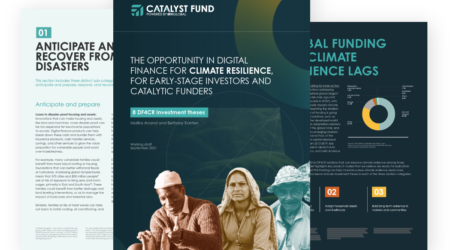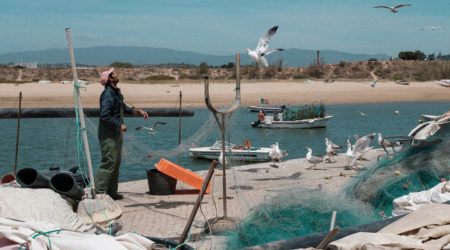Digital finance can enable 1 billion people to access climate resilience solutions by 2030

Climate change is here. An estimated 50 million people were impacted by climate disasters in 2020 alone, and this count doesn’t include those impacted by longer run changes in precipitation and temperature on their wellbeing and livelihoods. In 2021, there have been historic fires in the Western US, flooding in Germany, China, and India, and droughts in Brazil, Argentina, and Madagascar.
The landmark IPCC report from this year declared that even if we meet emissions targets, climate changes will get worse before they get better. While progress needs to be accelerated in reducing emissions, we urgently need to recognize the dual priority of building climate resilience to protect lives and livelihoods of climate-vulnerable populations globally.
To that end, the UN climate champions team has set a goal to improve the climate resilience of 4 billion people by 2030 — over half of the global population. All eyes are on the COP26 conference and negotiations this November to see if climate resilience is part of the discussion in a meaningful way, alongside real progress on emissions reduction.
But every day we wait for action on climate change comes with a cost, and it’s borne by those who can least afford it. Those most affected are in low-income communities around the world who don’t have the resources or the tools to cope with what we’re already experiencing today. Worse still, not only are they the most impacted, but they also contribute the least to climate change; they use less energy or other resources in their daily lives compared to wealthier households, who actually have the ability to adapt and withstand climate changes.
Solutions exist that can build resilience to climate change for low-resource and low-income households and communities. For example, basic financial products like insurance, livelihood-enabling technology like irrigation, and even simply better weather forecasting can improve the ability to anticipate, recover from, and adapt to climate changes. However, many of these solutions aren’t reaching scale quickly enough and aren’t reaching into the most climate vulnerable populations.
BFA Global, financially supported by PayPal, and including CGAP, UNCDF’s Better than Cash Alliance, the World Resources Institute, and the UN Race to Resilience, created a task force to explore how digital financial technologies like digital payments or embedded credit and insurance could enable greater access to these solutions, while broadening their reach and making them more affordable. We have seen other examples of digital finance catalyzing access to life-improving technologies: for example, pay-as-you-go solar technology that uses digital payments and embedded credit to enable access to affordable solar energy systems for millions of families without access to formal electricity.
Digital finance can be a critical tool for building climate resilience among the world’s poor and excluded who today represent the front line in the growing global climate emergency.
The Task Force on Digital Finance for Climate Resilience (DF4CR) estimates that digital financial services could help more than 1 billion people by 2030 gain access to climate resilience products and services, and that there is the potential for over US$25 billion in capital a year to flow into this emerging sector.
The DF4CR Task Force, bringing together global experts in climate and digital finance from over 50 additional organizations, has published a Framework for Action in the lead up to COP26 to provide a clear, actionable roadmap that shows how investors, innovators, funders, and policymakers can develop digital finance as an immediate, viable tool that vulnerable populations could use to confront the climate challenge.
The Framework calls on existing digital finance innovators to incorporate climate resilience considerations into their existing products and services already reaching financially-excluded communities. For example, inclusive fintech providers that offer credit to financially excluded populations should explore incorporating disaster insurance offerings or easily-deployable credit to invest in climate adaptation products like irrigation or improved housing materials.
Inclusive fintech provides can also be used as a communication channel for early warning systems – simply sending SMS alerts prior to extreme weather events. The Framework also calls on investors to promote innovators who can champion DF4CR and attract additional investors to the space. It additionally calls on investors to create investment vehicles with a more patient return profile to better suit the needs of DF4CR innovators.
The Digital Finance for Climate Resilience Framework for Action is an urgently-needed, experience-based roadmap to tackle the foremost threat to our planet today. Cutting through the conversations about extreme weather, the existential threat of climate change, and the lagging progress on emissions reductions, the Framework gives us a glimpse of a better future, charting a path for funders, innovators, investors, governments & policymakers, and enabler-bodies to make immediate progress towards building climate resilience through digital financial technologies.



